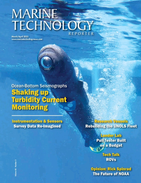Kelvin Hughes, a U.K. baesd designer and supplier of navigation and security surveillance systems, announced that it can now bring all the benefits of its SharpEye radar technology to submarines.
Traditionally, submarines only use radar for navigation in and out of port because a high power RF transmission can compromise its ability to remain undetected. However, with its low power output – up to 300W as opposed to the 25kW of legacy submarine radar systems – SharpEye can reduce the probability of detection by ESM systems.
Due to the solid state technology at the heart of SharpEye, it is now possible to locate the X-band transceiver downmast within the pressure hull, making use of the existing bulkhead infrastructure and the existing external antenna, rotational drive and waveguide connections. The downmast transceiver enclosure measures 743 x 487 x 330mm.
Moreover, the Doppler processing of the radar returns, means it can detect more targets, earlier and at a longer range. Delivering improvements in sub-clutter visibility of approximately 30dB, SharpEye can identify targets with a low Radar Cross Section (RCS), typically 0.5m2, even in adverse weather conditions. A series of electronic filters enables SharpEye to distinguish between targets of interest and sea and rain clutter.
With its patented pulse sequence, SharpEye enables multiple users to see the optimum picture simultaneously regardless of the radar range scale in use at each display.
Mark Bown, Kelvin Hughes’ Group Marketing Manager, commented, “Kelvin Hughes has a long history of supplying naval radar and 27 of the world’s navies are currently operating SharpEye systems. We’re delighted that we have been able to take this major step forward in submarine radar technology, ensuring submarines can now operate with a truly multipurpose naval radar system, covering navigation, surface search and bi-directional links to combat management systems.”
•  February 2025
February 2025



